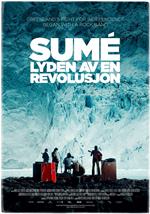 When touring Norwegian-based musician Mark Steiner was here in Australia recently he kindly thrust this upon me. It’s a DVD documentary about Greenland’s first rock band, Sume, which means “Where?” in Greenlandic.
When touring Norwegian-based musician Mark Steiner was here in Australia recently he kindly thrust this upon me. It’s a DVD documentary about Greenland’s first rock band, Sume, which means “Where?” in Greenlandic.
Greenland is a rather huge island continent, with a vast inhospitable interior and most of the population living in coastal villages, the population (mostly Inuit who settled there some 700 years ago) ruled by Denmark. Slowly but surely Denmark’s modern, western society eroded the culture and way of life of the Greenlanders; in order to get jobs (rather than fishing in kayaks) every young Greenlander had to go to Denmark to study. Meanwhile, older Greenlanders found their way of life being destroyed and being replaced with despair and purposelessness.
In 1972 four young Greenlanders, each from a different coastal village, met in Copenhagen … and formed a band. Malik Hoegh, the main lyric writer and singer-guitarist, and Per Bethelsen, produced songs in tune with the times of rebellion against an uncaring ruling state, even touting revolution as a way forward…
Greenlanders are rather shy. It was initially a great shock, I think, for them to find an LP "Sumut" (meaning ‘Where to?’, 1973) which summed up their situation with such clarity in songs of great beauty. Uncompromising, however, Sumut’s cover is a 19C Greenlandish woodcut of a Greenlander having killed a Danish trader, and waving the trader’s (severed) arm in triumph. The artist was familiar to all Greenlandish children as his art featured in many stories.
Greenlanders have - still - a quite disturbed past with Denmark. The relationship is, shall we say, tense. And there’s a nastily high suicide rate (not including the high consumption of alcohol). And with the permafrost melting in the north, previously inaccessible resources are becoming available …
Sume’s first LP essentially caused the beginning of an awakening of a practical politicisation of many Greenlanders. I won’t spoil the film for you, simply to say that;
- It’s bloody brilliant. Sume features the best use of incidental footage I have ever seen (I collect documentaries, by the way, and I suspect I’ve seen at least over 5,000 so far), and the most intelligent use of an icon.
Icon? you’ll figure it out. It’s done so cleverly that if you haven’t consciously figured out what it means, it becomes crystal clear at the end. Which, incidentally, makes the difference between a pretty damn good film and a brilliant one. - Sume’s music is pretty damn good. If you were alive in the ‘70s and remember the vast difference between the bloody awful and the damn good, you’ll be able to put Sume into perspective.
- I found the film tugging at the weary old heartstrings, and you will too. You’ll blub, you’ll laugh, you’ll gasp. "Sume" is not a blockbuster by any means, but as it tells a story about a struggling people, you’ll enjoy being reeled in.
- Sume’s LPs were released on vinyl (the Demos label). Amazon doesn’t have them. You’ll really have to look hard. But you could start by pestering these buggers here and here.
The latter has a translation capacity. The greatest problem with a native language documentary (you won’t notice the subtitles, I never do) is of course getting a review done in English so the wider world can appreciate the situation.
And if you must have a little more info go here.


 Three McGarretts and a dead Danski twat, Barman.
Three McGarretts and a dead Danski twat, Barman.
Oh, and P.S. Greenland likes tourists.


